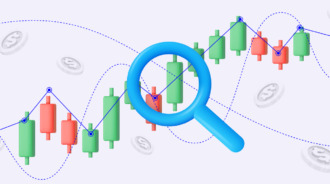

Arbitrage trading is an advanced approach that requires knowledge, confidence, and a deep understanding of markets. However, it’s a well-known technique used in forex, commodity, stock, and crypto markets, so it’s worth learning.
Arbitrage is represented by many types of strategies. Below, you will find the concept that relates to the financial markets the most.
What is arbitrage?
The idea of arbitrage trading is to gain rewards from the price difference between a single asset traded on different markets or in different forms. It can also be applied to the price differences between related financial instruments. A trader buys an asset for a lower price and sells it for a higher price on another market simultaneously, benefiting from tiny price differences.
This technique goes against the “law of one price.” It’s an economic concept that claims that the price of a single asset has the same value around the world, regardless of location, when certain factors are considered.
Arbitrage isn’t supposed to be a highly profitable strategy. The size of the rewards depends on the difference between prices. Therefore, a trader should look for a significant price divergence so rewards outweigh risks.
Arbitrage is often called “risk-free.” However, you should understand that there is no risk-free strategy. Any trading approach implies risks of wrong price predictions and capital loss.
There are numerous arbitrage techniques. Below, you will find a definition of the statistical arbitrage trading strategy and its types.

Statistical arbitrage trading strategies
Statistical arbitrage, also known as “stat arb,” was created in the 1980s when Morgan Stanley’s equity block trading desk needed a hedging strategy. The trading desk purchased many stocks in one company and sold closely-correlated stocks of another company to hedge investments against enormous market fluctuations.
Later, traders transformed this “pairing” into one strategy that allowed them to gain from price differences. As a result, traders can take advantage of statistical price differences caused by liquidity, risk, volatility, or other fundamental and technical reasons.
An example will make the explanation easier. Shares of The Coca-Cola Company and PepsiCo usually move similarly. If you notice a divergence in their price movements, this may be a sign of a temporarily exploitable opportunity.
It’s believed that the divergence will last for a short term, as, usually, the shares move in the same direction (mean reversion). To apply the statistical arbitrage approach, you should buy the declining stock and sell the one that rises. A trader hopes for the prices to converge again.
The statistical approach includes several trading strategies, including risk arbitrage, high-frequency trading, neural networks, and volatility arbitrage.
Volatility arbitrage trading strategy
This is a strategy based on the assumption of the size of the upcoming volatility. A trader should be able to project an upcoming volatility degree of the underlying asset and find the one whose current volatility is either lower or higher. Numerous fundamental factors can cause the difference in volatility. For the stock market, they include uncertainties around earnings reports, merger and acquisition speculations, and patent disputes.
If a trader believes the current volatility of an asset is underestimated, they open a buy trade for the call and sell the underlying asset to hedge. As a result, the trader’s portfolio becomes delta neutral. The trade is considered successful with the unchanged stock price when the implied volatility rises, and the asset reaches its fair price.
You can use the inverse rules for the overestimated asset, selling a calland buying the underlying asset.
The strategy implies risks related to the wrong assumption, whether the asset is over- or undervalued, the timing for holding the positions, and the change in the underlying asset’s price.

Types of arbitrage
1. Pure arbitrage
With pure arbitrage, investors can buy and sell certain security in distinct markets at the same time. Thus, they are able to take advantage of the price differences. It is possible to buy and sell various investments in different markets. Some companies, like large multinational ones, can appear on various exchanges, which could include the London Stock Exchange and New York Stock Exchange.
If an asset can be traded in various markets, possible prices may not work together simultaneously. This price difference is what makes room for pure arbitrage.
Many times, “pure arbitrage” and “arbitrage” are used as interchangeable terms.
2. Merger arbitrage
Merger arbitrage has to do with merging entities – for instance, two businesses that are publicly traded. This arbitrage type is also known as risk arbitrage.
Any merger arbitrage consists of two parties, respectively a company that acquires another, with the latter being the target company. An acquiring company will have to buy the target company’s outstanding share if the target one is a publicly traded entity.
Shareholders typically make some nice profit as the acquiring company does this. That’s because it occurs at a premium to what the stock is actually trading for when the announcement is made. As soon as the deal is made public, traders become interested in buying the stock of the target company to make some profit from the deal.
3. Convertible arbitrage
Convertible arbitrage is extremely popular among traders as well. It is related to convertible notes, also known as convertible bonds.
Bonds represent a corporate debt form that gives the bondholder interest payments. Traditional bonds and convertible bonds are different as the latter gives bondholders the opportunity to turn them into shares of the underlying company at a lower rate and at a later time. And because giving convertible bonds can lead to decreased interest payments, many firms issue them.
Examples of arbitrage
Let’s take a look at an easy example of arbitrage.
Imagine a company that is currently trading on the New York Stock Exchange (NYSE) at $19, while trading on the London Stock Exchange (LSE) for $19.05 simultaneously. Then, a trader can buy that stock on NYSE, then sell the shares on LSE, allowing them to make a 5-cent per share profit.
After that, the trader may decide to take advantage of this arbitrage for a while, until the NYSE specialists have no move stock inventory left for that company. They may also keep going until either LSE or NYSE specialists fix their prices in order to eliminate the opportunity.
Why is arbitrage important?
Arbitrage is important for traders as it can boost financial market efficiency. The difference in price between similar or identical assets gets smaller as arbitrage traders buy and sell. Assets with higher values get sold off, whereas those with lower values are bid up.
Therefore, arbitrage can solve any market pricing inefficiencies and it contributes to market liquidity. Traders like it due to how much it can help them make a profit.
Takeaway
Arbitrage trading includes numerous types and strategies. You can apply this technique to numerous markets. Therefore, first, you should determine what assets you want to trade. Second, you need to determine which approach works the best. Only after that should you try trading using divergence in prices.
Disclaimer: No strategy can guarantee a 100% correct trade outcome.










